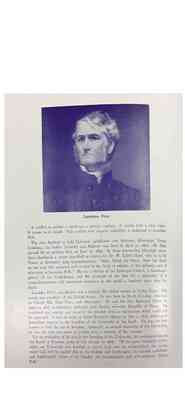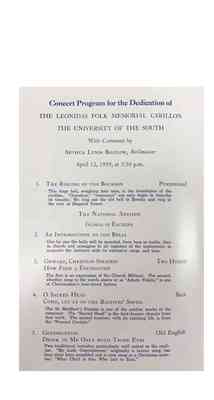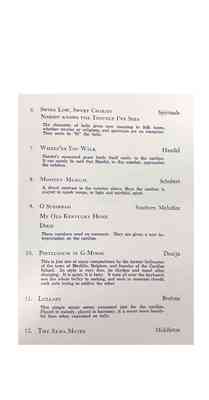Pages
1
The Leonidas Polk Memorial Carillon All Saints’ Chapel Shapard Tower The University of the South Sewanee, Tennesse
2
Photo of Leonidas Polk
A carillon is neither a timid nor a neutral creation. It speaks with a clear voice. It means to be heard. This carillon with singular suitability is dedicated to Leonidas Polk. The man destined to hold Episcopal jurisdiction over Arkansas, Mississippi, Texas, Louisiana, The Indian Territory and Alabama was born on April 10, 1806. He died, pierced by an artillery ball, on June 14, 1864. In those intervening fifty-eight years there developed a career described as follows by Dr. W. Cabell Greet, who is to be Orator at Sewanee's 1959 Commencement: "After Alfred the Great, there has lived no none man who achieved such stature in the [fields?] of religion, of the military, and of education as Leonidas Polk." He was bishop of the Episcopal Church, a lieutenant-general of the Confederacy, and the projector of the idea for a university of a comprehensiveness still unrealized anywhere in the world a hundred years after his death. Leonidas Polk's grandfather was a general. His father served at Valley Forge. His cousin was president of the United States. He was born in North Carolina, educated at Chapel Hill, West Point, and Alexandria. He was the first Episcopal bishop in America with ecclesiastical authority over foreign [soil?]--the Republic of Texas. He combined zeal, energy and capacity for research with an ethusiasm which could not be quenched. It was his letter to fellow Southern bishops on July 1, 1856, which gave immediate impetus to the founding of the Univeristy of the South. He was the first trustee to visit the site at Sewanee. Ironically, as second chancellor of the University, he was the only one never to preside over a meeting of the trustees. For an evaluation of his role in the founding of the University, his contemporaries on the Board of Trustees spoke in this manner in 1867: "If the great beneficials results which our University was founded to secure shall ever be accomplished, the praise, under God, will be mainly due to the wisdom and forethought, the hopeful confidence and indefatigable labors of its founder, the magnanimous and self-sacrificing Bishop Polk."
3
Excerpts from ORDER OF SERVICE THE DEDICATION OF THE LEONIDAS POLK MEMORIAL CARILLON
April 12, 1959 Psalm 150 O PRAISE GOD is his sanctuary: *praise him in the firmament of his power. Praise him in his noble acts: * praise him according to his excellent greatness. Praise him in the sound of the trumpet: *praise him upon the lute and harp. Praise him in the timbrels and dances: *praise him upon the strings and pipe. Praise him upon the well-tuned cymbals: *praise him upon the loud cymbals. Let every thing that hath breath *praise the Lord. Glory be to the father, and to the Son, and to the Holy Ghost; as it was in the beginning, is now, and ever shall be, world without end. Amen.
Prayers: Bishop: Let us pray. Grant, O Lord, that whosoever shall be called by the sound of these bells to Thine House of prayer, may enter into Thy gates with thanksgiving, and into Thy courts with priase, and finally may have a portion in the new song in Thine house not made with hands, eternal in the heavens, through Jesus Christ our Lord. Amen. Grant, O Lord, that they who, by reason of sickness or other hindrance, cannot come into the house of the Lord, may hear the voice of these bells, and thereby be brought hither in heart and mind to share in the communion of Thy Saints, through Jesus Christ our Lord. Amen. Grant, O Lord, that they who with their outward ears shall hear the sound of this carillon, may be aroused inwardly in their spirits, and draw nigh unto thee, the God of their salvation, through Jesus Chrsit our Lord. Amen.
4
Concert Program for the Dedication of
THE LEONIDAS POLK MEMORIAL CARILLON THE UNIVERSITY OF THE SOUTH
With Comment by
ARTHUR LYNDS BIGELOW, Bellmaster
April 12, 1959, at 3:30 p.m.
1. THE RINGING OF THE BOURDON Processional
This huge bell, weighing four tons, is the foundation of the carillon. "Grandeur," "resonance" can only begin to describe its tonality. We ring out the old bell in Breslin and ring in the new at Shapard Tower.
THE NATIONAL ANTHEM
GLORIA IN EXCELSIS
2. AN INTRODUCTION TO THE BELLS
One by one the bells will be sounded, from bass to trele, then in chords and arpeggios in all registers of the instrument, to acquaint the listeners with its extensive range and tone.
3. ONWARD, CHRISTIAN SOLDIERS HOW FIRM A FOUNDATION Two Hymns
The first is an expression of the Church Militant. The second, whether sung to the words above or as "Adeste Fidelis," is one of Christendom's best-loved hymns.
4. O SACRED HEAD COME, LET US TO THE BAGPIPES' SOUND Bach
The ST. Matthew's Passion is one of the noblest works of the composer. The "Sacred Head" is the best-known choral from that work. The second number, with its catching lilt, is from the "Peasant Cantata."
5. GREENSLEEVES DRINK TO ME ONLY WITH THINE EYES Old English
Two traditional melodies particularly well suited to the carillon. "My Lady Greensleeves," originally a tavern song, has long since been ennobled and is now sung as a Christian number, "What Child is this, Who laid to Rest."
5
6. SWING LOW, SWEET CHARIOT Spirituals NOBODY KNOWS THE TROUBLE I'VE SEEN The character of bells gives ne wmeaning to folk tunes, whether secular or religious, and spirituals are no exception. They seem to "fit" the bells.
7. WHERE'ER YOU WALK Handel Handel's measured grace lends itself easily to the carillon. It can surely be said that Handel, in this number, approaches the sublime.
8. MOMENT MUSICAL Schubert A direct contrast to the number above. Here the carillon is played in quick tempo, in light and mirthful spirit.
9. O SUSANNAH Southern Melodies MY OLD KENTUCKY HOME DIXIE These numbers need no comment. They are given a new interpretation on the carillon.
10. POSTLUDIUM IN G-MINOR Denijn This is just one of many compositions by the former bellmaster of the town of Mechlin, Belgium, and found of the Carillon School. Its style is very free, its rhythm and mood often changing. It is quiet; it is lusty. It runs all over the keyboard, sets the whole belfry to rocking, and end in resonant chords, each note trying to outlive the other.
11. LULLABY Brahms This simple music seems composed just for the carillon. Played in melody, played in harmony, it is never more beautiful than when expressed on bells.
12. THE ALMA MATER Middleton




